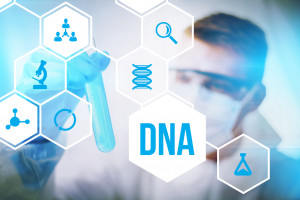We know that DNA from tumor cells floats in the bloodstream in early stages of lung and liver cancer. With a new computer program, some research scientists are now seeing this as an opportunity for early cancer detection. We could call the new method of diagnosis a blood biopsy! The new machine/computer program that can do it is called the “CancerLocator.”
Read more below, to learn why!
Early Cancer Detection: By Computer?
Detecting cancer and identifying where in the body it is located through a patient’s blood sample sounds like a futuristic dream or a science fiction movie plot. However, Professor Jasmine Zhou, co-lead author from the University of California at Los Angeles, believes she has a computer-driven test that can accomplish the type of cancer in a patient from a single blood sample.
Her reason for the research study was passionate. She said: “Non-invasive diagnosis of cancer is important, as it allows the early diagnosis of cancer, and the earlier the cancer is caught, the higher chance a patient has of beating the disease.”

Tracking cancer by its DNA Footprint is the mission of the “CancerLocator” computer program.
At Florida Lung, Asthma and Sleep Specialists, we follow research such as this to bring you the latest progress in research. Every day new studies are improving our lung cancer patient’s chances of survival. Professor Zhou’s computer program might save patients before their tumors became advanced and their condition critical.
So FLASS doctors and staff found her intensive research quite interesting. Likewise, journalists in the US and the UK have begun to spread the world, publicizing the story of ground-breaking cancer detection only a few days ago, here in March of 2017.
To put it simply, she stated, “We have developed a computer-driven test that can detect cancer, and also identify the type of cancer, from a single blood sample.
Prof. Zhu’s New Computer Program: Code-Named “CancerLocator”
1. …Detects cancer through the DNA released by tumors.
2. …Identifies where the cancer is located.
3. …Diagnosis and location are accomplished by a minimally invasive blood test.
How The Computer Program Tracks The Tumors
It seems deceptively easy, but any one knows that tracking down tumors has never been easy
1. The new computer program does its tumor tracking by searching for very specific molecular patterns patterns…
2. These patterns are found in cancer DNA that (cringe!) flows freely in a patients’ blood.
3. Then the computer goes to work comparing the patterns against a database of tumor epigenetics.
4. The epigenetics were collated by the authors of the program.
Tracking the Footprints of Cancer
Professor Zhou explained: “We built a database of epigenetic markers, specifically methylation patterns, which are common across many types of cancer…”
FLASS noted that they were specific about the methylation patterns originating from lung and liver cancerous tumors.
Additionally, they also input the “molecular footprint” for non-cancerous samples. This gave the scientists a baseline with which to compare cancerous samples.
The Premise and Specifics: The New Tumor Tracking Research Study
The researchers of the scientific study expressed their theory boldly, “We propose a probabilistic method, CancerLocator, which

The Mission: Researchers want to track down cancer in the early stages, and stop it at the molecular level.
exploits the diagnostic potential of cell-free DNA by determining not only the presence but also the location of tumors.”
Named the “CancerLocator,” they put their new program to the test with numerous blood samples. They also made the new computer program compete with two other techniques called Random Forest and Support Vector Machine.
They tested blood samples from:
29 liver cancer patients,
12 lung cancer patients
and 5 breast cancer patients.
The Procedure for the Research
A. Tests were run 10 times on each sample to validate the results.
B. The Random Forest and Support Vector Machine methods had an overall error rate of 0.646 and 0.604 respectively. The error rate indicated misdiagnosis by a false-positive reading.
C. However, Prof. Zhu’s new computer program obtained a lower error rate of 0.265. Dr. Zhu said, “The technology is in its infancy and requires further validation, but the potential benefits to patients are huge.”
The Results of the Tests
Remarkably, 25 out of the 29 liver cancer patients and 5 out of 12 lung cancer patients tested in this study had early stage cancers.
The computer program detected the tumor in 80% of cases. It is impressive that the computer program could detect the tiny amounts of tumor DNA present in the patients’ blood at early stages.
Florida Lung, Asthma and Sleep Specialists feel this test, although very small in numbers of cases, was effective in “demonstrating the potential of this method for the early detection of cancer, according to the researchers.”
Likewise the test outperformed its standard, less specific and less accurate diagnostic competitors.
Professor Zhou concluded, “Owing to the limited number of blood samples, the results of this study are evaluated only on three cancer types (breast, liver and lung).”
Here in Orlando, we at FLASS note that this new diagnostic tool is in its very beginning rendition. We know the study of this computer program has barely begun, but our hopes run high that it will be perfected, tested on thousands of samples and fast-tracked into a diagnostic tool of the near future.
Prof. Zhu explained, “…the higher the fraction of tumor DNAs in blood, the more accurate the program was at producing a diagnostic result. Therefore, tumors in well-circulated organs, such as the liver or lungs are easier to diagnose early using this approach, than in less-circulated organs such as the breast.”
This is not a report of a machine that will only happen centuries from now. We don’t believe it will be a long time before this “blood biopsy” diagnostic machine will be quite available to physicians.
Dr. Zhu stated, “I hope it [a diagnostic test] will be available within a year. It depends on training data, testing and machine learning.”
We know there are many patients and future patients who join us in hoping they can make the CancerLocator a reality soon.


